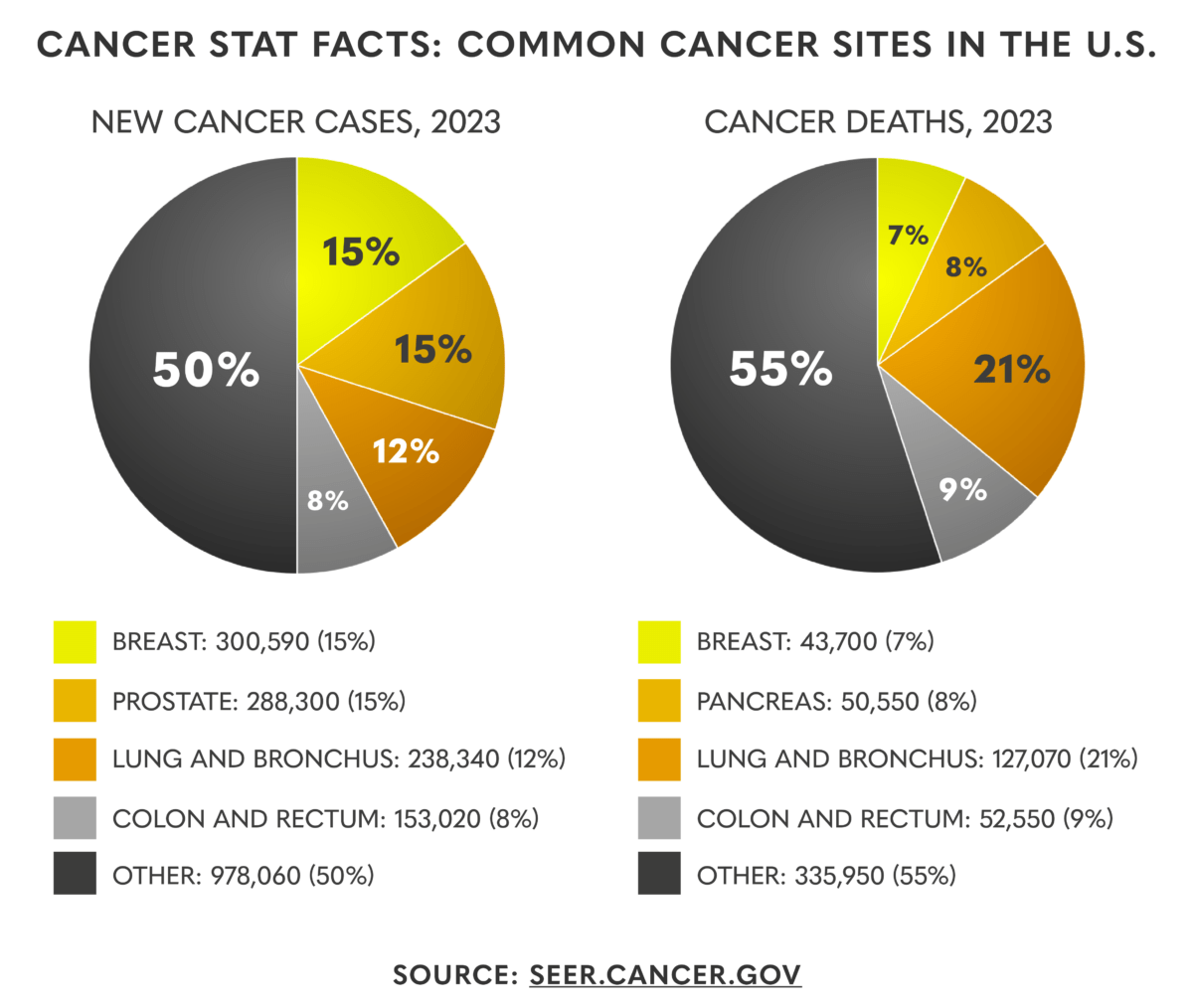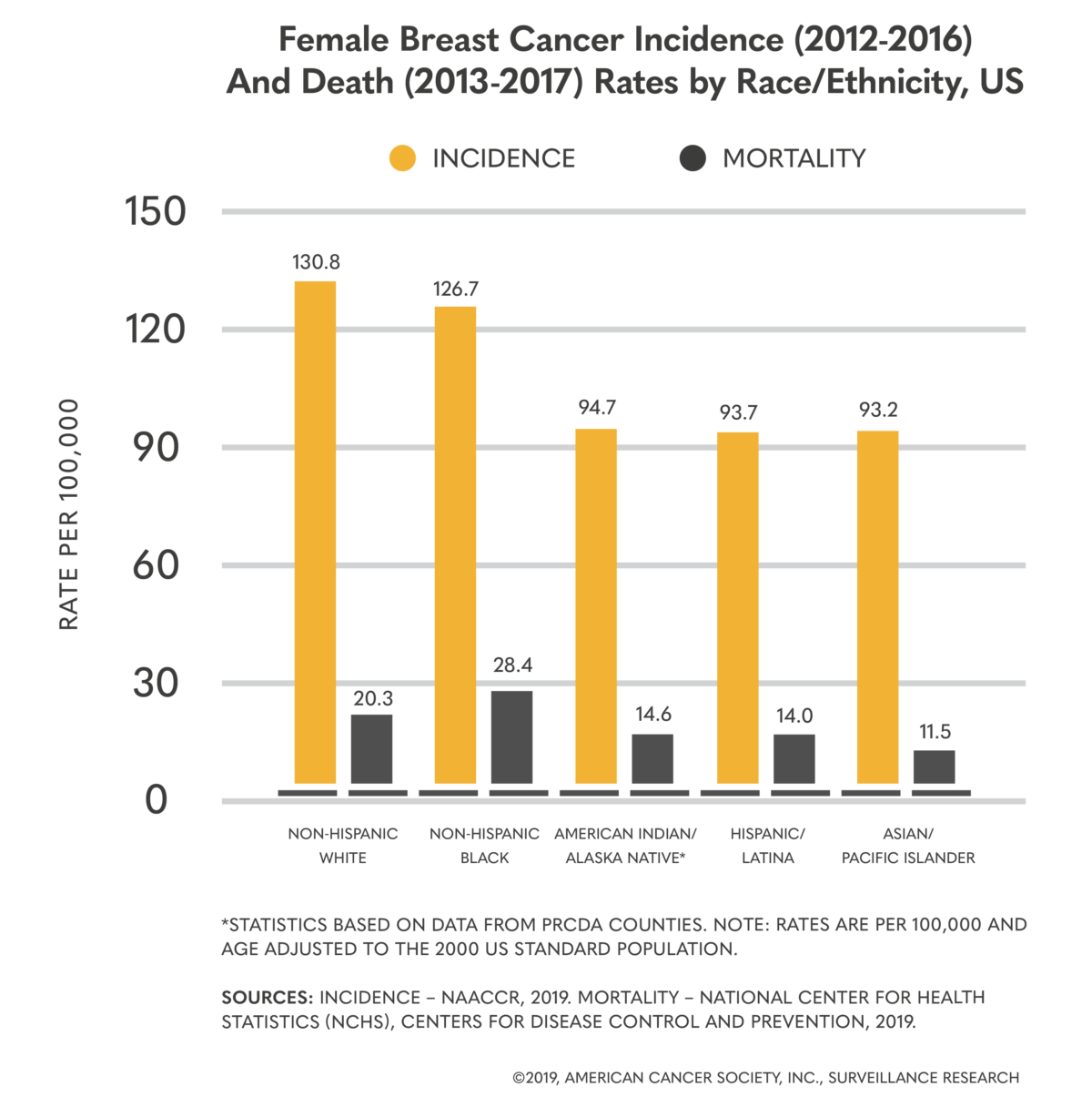
Note: This blog was sobering to research and write and will undoubtedly be sobering to read. Full of recent statistics related to cancer diagnosis, prognosis, and treatment, this blog is intended to provide helpful resources for patients, providers, caregivers, and facility managers. The information contained in this article was not written by a medical professional; please consult a licensed physician or oncologist for proper care.
Cancer is a major public health problem worldwide and is the second leading cause of death in the United States.
According to the National Cancer Institute, in 2023, roughly 2 million people will be diagnosed with cancer in the United States. An estimated 297,790 women and 2,800 men will be diagnosed with breast cancer, which makes it the most common cancer diagnosis. Prostate cancer is the leading cancer diagnosis among men and the second most common diagnosis overall with 288,300 expected cases.
What Is Cancer—and How Does It Start?
Any type of “cancer” is caused by an overgrowth or abnormal mutation of cells in the body. A “tumor” is any abnormal proliferation of cells, which may either be benign or malignant. “Benign” means the mass of cells is not cancerous, and “malignant” means cancer is present.
Basically, “cancer” is the term assigned when cells divide uncontrollably and spread into surrounding tissues. If the abnormal cells continue to divide unstopped, they can damage the healthy tissue around them, causing normal cells to stop working properly. However, not all cancers are fatal, and some of causes of death include:
Sign up to get the latest industry news and offers right in your inbox
- Organ failure due to the size and pressure of the tumor
- Complications during surgery to remove the tumor
- Organ rupture due to the size of the tumor
- Infection due to the immune system’s inability to fight illness during cancer treatment
Cancer can start anywhere in the body, and cancers that begin in organs such as the skin, breast, or prostate and spread elsewhere are considered to have “metastasized.” Cancer can be caused by genetic or environmental factors, but not all causes can be pinpointed nor prevented.
One thing medical experts agree on is this: A delay in diagnosis and/or treatment can contribute to an increase in advanced-stage disease and mortality.

This infographic shows that breast, lung/bronchus, prostate, and colorectal cancers account for almost 50% of all new cancer cases in the United States—and that lung/bronchus, colorectal, pancreatic, and breast cancers are responsible for nearly 50% of all U.S. deaths.
Breast Cancer Statistics in the United States
We wrote in detail about lung cancer in last month’s blog “Research and Education Help Improve Our Odds Against Lung Cancer,” so this month we want to include information on breast and prostate cancer, since those are the top cancer diagnoses in the United States.

- More than 4 million women with a history of invasive breast cancer were alive on January 1, 2022.
- Some of these women were cancer-free, while others still had evidence of cancer and may have been undergoing treatment.
- More than 150,000 breast cancer survivors are living with metastatic (stage IV) disease, three-fourths of whom were originally diagnosed
with stage I-III cancer. - Approximately 1 in 8 women (13%) will be diagnosed with invasive breast cancer in her lifetime and 1 in 39 women (3%) will die from
breast cancer. - A woman’s individual risk varies by age and race/ethnicity, as well as family, medical, and reproductive history.
- Breast cancer incidence increases with age until the seventh decade of life.
- More than half of the diagnoses occur in women 62 or younger.
Prostate Cancer Statistics in the United States
Cancer.org goes on to share stats regarding prostate cancer in the U.S.
- Other than skin cancer, prostate cancer is the most common cancer in American men.
- Nationwide, there will be approximately 288,300 new cases of prostate cancer in 2023, and about 34,700 deaths from prostate cancer in 2023.
- About 1 man in 8 will be diagnosed with prostate cancer during his lifetime.
- The average age at first diagnosis is around 66.
- Prostate cancer is the second leading cause of cancer death in American men, behind only lung cancer; roughly 1 man in 41 will die of prostate cancer.
- More than 3.1 million men in the United States who have been diagnosed with prostate cancer at some point are still alive today.
For all cancers, regular screenings and a healthy lifestyle are important—no matter the person’s age or gender. And these factors can become increasingly important based on age or family history.
Common Statistics for Chemotherapy Treatment
There are various options for cancer treatment, depending on the cancer and the doctor’s findings. Some include surgery, radiation, and chemotherapy.
Most commonly administered intravenously, chemo treatment requires patients to sit for extended periods of time. The diagnosis and prognosis can be traumatic enough; treatment shouldn’t be a traumatic experience too.
- While there are various facilities and clinics offering cancer treatment nationwide, there are 72 NCI-Designated Cancer Centers, located in 36 states and the District of Columbia, that are funded by the National Cancer Institute to deliver cutting-edge cancer treatments to patients.
- Experts at MD Anderson explain that the length of a chemotherapy treatment depends on the cancer type, location, and size—as well as the chemotherapy. A regimen can range from 5 minutes to 8 or more hours.
- According to Medical News Today, a single course of chemotherapy will typically involve four to eight chemo cycles. For example, a 4-week cycle could involve someone taking medications on the first, second and third days, then no further medication until the 29th day. A doctor decides the length of duration.
- On average, a patient will need 3 to 6 months of chemotherapy treatment.
While painful nerve damage can be a short-term side effect of chemo, and hair loss, nausea, and fatigue can be longer side effects, the treatment session itself should be as comfortable and peaceful as possible. Providers need easy access to the patient, and patients must be afforded as much independence, privacy, and comfort as possible during each IV session.
Providing Comfort and Care for Oncology Patients
Keeping patients comfortable and safe during long oncology treatments is crucial. At Champion, we ensure that healthcare professionals have the clinical access and ease of use they need, while creating a comforting and reassuring experience for the patient.
The Ascent is an upscale, stylish recliner, featuring swing-away arms for patient transport, and extra padding for increased comfort.
Champion’s Alō Series is the perfect combination of patient functionality, caregiver access, modular design, comfortable aesthetics, and luxurious features.
The Ascent, the Alō Treatment, and the Alō Recovery recliners are all used in oncology settings. And there’s no better time to choose an Alō recliner than right now! For a limited time, we’ve reduced the MSRP on every power Alō.
When 2023 ends, so do the savings. Now is your chance to upgrade your facility and provide premium comfort to your patients—with Champion’s flagship offering, the Alō.
Click the button below to learn more. We’re happy to help!
